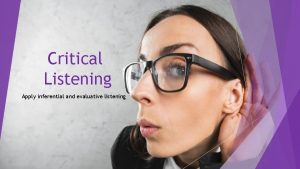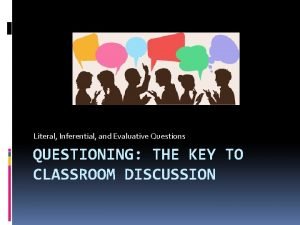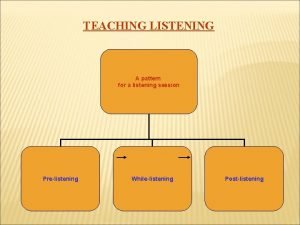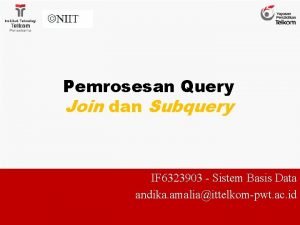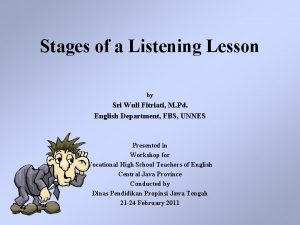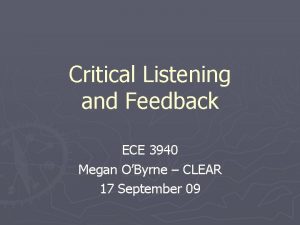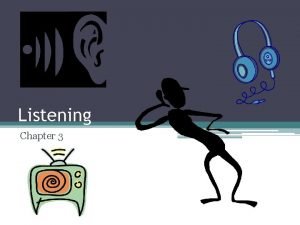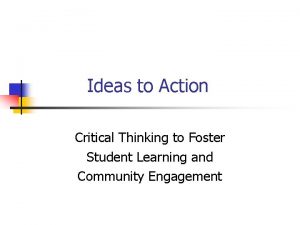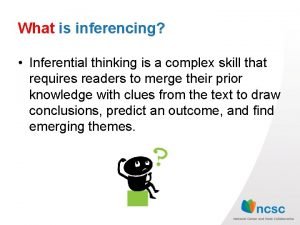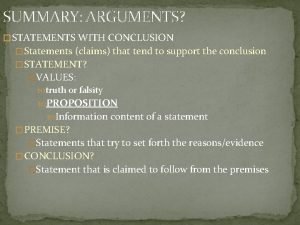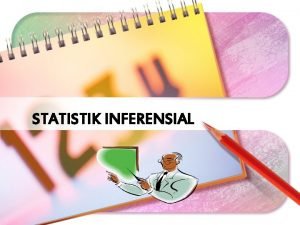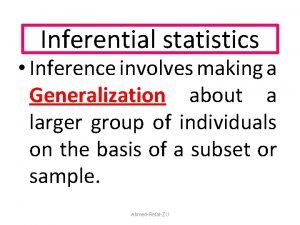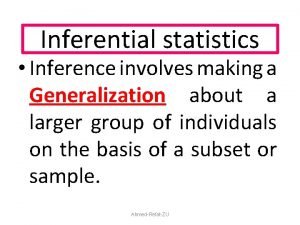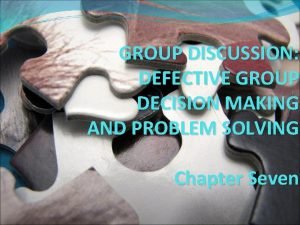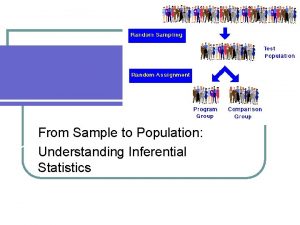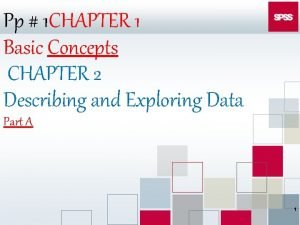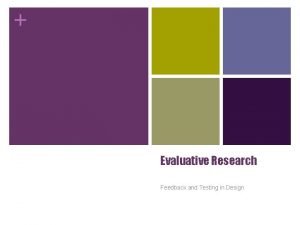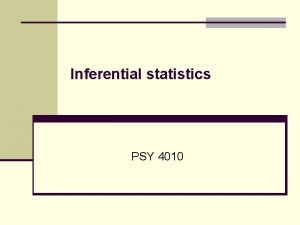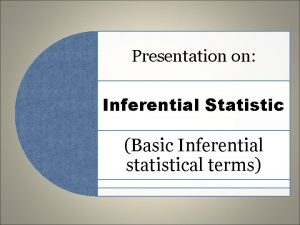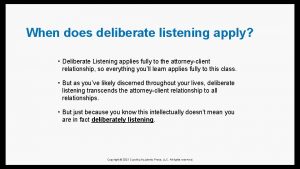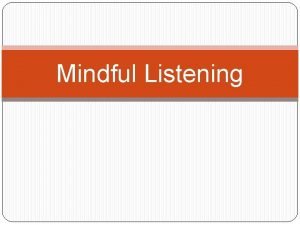Critical Listening Apply inferential and evaluative listening Standards

































- Slides: 33

Critical Listening Apply inferential and evaluative listening

Standards This presentation is based on the competency standards for NVQ Level 4 Language and Communication (LAC 40117) Cluster 2 | Deliver Oral Presentations Unit | LLLCOM 0014 A Develop and apply oral expressions and critical listening Competency Elements: 1. Organise oral communication in a cogent manner 2. Apply inferential and evaluative listening 3. Deliver effective oral presentations to diverse audiences for varied purposes Content Writer | Alecia Campbell | 2019

Objectives After completing this presentation, the accompanying guide and activities you will be able to: Define at least three (3) types of audiences, outlining the needs and recommended strategies to meet their expectations Describe at least six (6) different speaking situations, outlining the purpose and expectations of the audience in each setting, Outline at least three (3) different points of view which could be employed while delivering a speech, Identify at least five (5) characteristics each of appropriate introductions, supporting details and effective conclusions needed to organize oral communication in a cogent manner. Categorize at least five (5) classes of transitional phrases used to show linkages in ideas Describe at least five (5) types of paralanguage List at least eight () verbal and non-verbal techniques to communicate information. Diagram at least three (3) sentence structures useful in avoiding monotony in speeches and oral presentations Distinguish between the strengths and weaknesses of speeches and oral presentations, in terms of content and context Describe at least five (5) digital media options which may be used strategically in presentations to enhance understanding of findings, reasoning and evidence and to add interest.

Objectives continued Outline expository speeches containing appropriate introductions, supporting details and effective conclusions Demonstrate at least three (3) techniques to avoid monotony in speech Showcase your ability to speak with clarity and persuasion while initiating and participating in discussions Demonstrate at least five (5) principles of active listening including effective note taking techniques Evaluate the content of selected local and international speeches by applying inferential and evaluative listening Demonstrate the correct pronunciation of at least twelve (12) commonly mispronounced words Explain the correct usage of at least twelve (12) commonly misused words Justify the need for using appropriate introductions, credible details and effective conclusions, by stating at least three (3) reasons for each Defend the need for an engaging delivery, by proposing at least three (3) strategies to avoid monotony and improve participation Convince your peers of the importance of context, background knowledge, values and experience on communication by outlining at least three (3) ways to avoid bias or find common ground

Required Reading Saylor Academy (2012) Stand Up and Speak Out – The Practice and Ethics of Public Speaking Chapter 4 – The importance of Listening Chapter 5 – Audience Analysis Chapter 6 – Finding a purpose and selecting a topic Chapter 7 – Researching Your Speech Chapter 8 – Supporting ideas and Building Arguments Chapter 9 – Introductions matter: How to begin a speech effectively Chapter 10 – Creating the body of your speech Chapter 11 - Concluding with power Chapter 12 – Outlining Chapter 14 – Delivering the Speech Chapter 15 – Presentation Aids: Design and Usage Pronunciation Guide for English and Academic Dictionaries

Outline 1. Fundamentals of Critical Listening 1. Types of Listening 2. Active listening 3. Note taking

Critical Listening Listen to an overview of this unit by clicking on the icon above.

FUNDAMENTALS OF CRITICAL LISTENING PURPOSE | TOPIC | AUDIENCE ANALYSIS

Are you listening? Click on the video and listen to Mateo as he tries to pleads his case for a cupcake. • What is he doing wrong when it comes to listening? • What could he do differently?

Listening is the least emphasized mode of communication. While we all have likely received some formal education in terms of reading and writing (written or text-based communications) and we have probably been taught or trained to speak and present (as a spoken form of communication), it is rare that we get much instruction on how to receive spoken (oral or audio) communication through listening (which is much more than hearing).

Activity Watch (and listen!) to this 7 minute TEDx Talk on Listening Are you familiar with his tips? Do they remind you of daily interactions in your life? Jot notes to yourself and begin to think about how non-verbal listening skills play a part in your world.

Why we listen? To specifically focus on the messages being communicated, avoiding distractions and preconceptions. To gain a full and accurate understanding into the speakers point of view and ideas. To critically assess what is being said. (See our page on Critical Thinking for more). To observe the non-verbal signals accompanying what is being said to enhance understanding. To show interest, concern and concentration. To encourage the speaker to communicate fully, openly and honestly. To develop an selflessness approach, putting the speaker first. To arrive at a shared and agreed understanding and acceptance of both sides views. Read more at: https: //www. skillsyouneed. com/ips/listening-skills. html

Active Listening Active listening is more than just hearing someone speak. It requires you to be engaged in the moment, to receive the words and body language of someone else, meaningfully. Only then can you feel empathy for the speaker--that is, try to feel what they’re feeling. Active listening involves listening with all senses. As well as giving full attention to the speaker, it is important that the ‘active listener’ is also ‘seen’ to be listening - otherwise the speaker may conclude that what they are talking about is uninteresting to the listener. Interest can be conveyed to the speaker by using both verbal and non-verbal messages such as maintaining eye contact, nodding your head and smiling, agreeing by saying ‘Yes’ or simply ‘Mmm hmm’ to encourage them to continue. By providing this 'feedback' the person speaking will usually feel more at ease and therefore communicate more easily, openly and honestly. Read more at: https: //www. skillsyouneed. com/ips/active-listening. html

General Types of Listening Discriminative listening is the most basic form of listening and does not involve the understanding of the meaning of words or phrases but merely the different sounds that are produced. Comprehensive listening involves understanding the message or messages that are being communicated.

Specific Types of Listening Informational Listening - Listening to Learn Critical Listening - Listening to Evaluate and Analyse Therapeutic or Empathetic Listening - Listening to Understand Feeling and Emotion Appreciative listening is listening for enjoyment. Rapport Listening is used when trying to build rapport with others. This type of listening encourages the other person to trust and like us. Rapport listening is commonly used by salesmen and during negotiations. Selective listening is listening only to what we want to hear and excluding all other. It is negative and is to be avoided.

Critical Listening Critical listening involves analysis of the information being received and alignment with what we already know or believe. usually involves some sort of problem solving or decision making. analysing opinion and making a judgement

How to listen critically Critical listening does not mean finding fault with what is being said. Rather it involves engaging in what you are listening to by asking yourself questions such as: what is the speaker trying to say? what is the main argument being presented? how does what I’m hearing differ from my beliefs, knowledge or opinion?

How to improve Critical Listening Critical listening can be improved by employing one or more strategies to help the listener analyze the message: Recognizing the Difference between Facts and Opinions Uncovering Assumptions Be Open to New Idea Rely on Reason and Common Sense Relate New Ideas to Old Ones Take useful Notes For more information read Chapter 4, The Importance of Listening from Stand Up, Speak Out: The Practice and Ethics of Public Speaking

Activity Create a handout that includes an explanation of types of listening and how to engage in active and critical listening. Your content could be in the form of an info-graphic , a brochure or other appropriate handout. Copies of your handout are to be shared with trainees.

The outcome of active listening As we listen we not only learn new information reinforce previous knowledge but also exhibit more complex interactions including: AFFECTIVE processes, such as being motivated to assist others, BEHAVIORAL processes, such as responding with verbal and non-verbal feedback, and COGNITIVE processes, such as attending to, understanding, receiving, and interpreting contextual and relational messages.

Signs you are truly listening This chart shows the profile of a good listening by outlining verbal and nonverbal competencies. Source: Bodie, G. D. , St. Cyr, K. , Pence, M. , Rold, M. , & Honeycutt, J. (2012). Listening competence in initial interactions I: Distinguishing between what listening is and what listeners do. International Journal of Listening, 26(1), 1 -28.

Activity Watch this 1. 5 minute video excerpt from the Big Bang Theory (an American television sitcom that ran from 2007 to 2019). In it they are parodying active listening. Observe Amy's listening skills when Sheldon is discussing a topic of little interest to her. Using the listener profile on the previous slide, identify affective, behavioral, and if possible cognitive competencies Amy is employing both while not actively listening and while feigning active listening.

Activity Keep a listening log or journal for a week. Several times a day, observe your own listening tendencies and those of others. Record your observations in a journal. At the end of each day, select one tendency you'd like to improve and create an action plan using theories and research learned in this module. In subsequent days, assess the results of your modified approach to listening.

Note taking is one of the active listening skills that you will need to acquire. Note taking involves keeping a record for yourself, a record that you can go back to later on, whether for revising for examinations or for making links with later parts of the various courses you are studying.

Purpose of note taking Notes to assist retention: note-taking and note-making greatly increases the chances of recalling the information. Notes for revision: This is perhaps the most important function of notes. You can perform better when you revise from your own notes. Notes for external storage: when you record what has been said during any presentation, this acts as a storage mechanism of these facts and ideas. Notes as preparation for written assignments. Notes you take may be used to expand the concepts to be discussed or they could be incorporated in the writing process. Extensive and intensive reading and making notes will enable you to focus on the topic or subject of the assignment.

How to take notes Taking notes does not imply simply taking things down more or less word for word, of what the speaker says. Rather, it is a selection and it needs to be organized and it will include the most important or interesting parts of the lecture that you have been listening to. When taking notes, be brief and write fast. But later when you go back to look at the notes, you may add some details and provide various examples, thus making them more detailed and clearer and also editing any errors

Note taking Tips Listening with concentration to that there is an understanding of what is being said. Selecting the main points from the lecture or presentation. Omit unnecessary words without losing the essential meaning. The use of abbreviations, acronyms and symbols are appropriate.

Activity Practice taking notes as you review the presentations for this module.

Glossary Diphthong – sound formed by the combination of two vowels in a single syllable Impromptu speaking - presentation of a short message without advance preparation. Extemporaneous speaking - presentation of a carefully planned and rehearsed speech, spoken in a conversational manner using brief notes. Manuscript speaking - word-for-word iteration of a written message. Memorized speaking - rote recitation of a written message that the speaker has committed to memory. Monotony – delivered in flat, unemotional style Paralanguage - non-lexical component of communication by speech, for example intonation, pitch and speed of speaking, hesitation noises, gesture, and facial expression.

Oral Expression For information on Oral Expression: Pronunciation Phonetics Enunciation Fluency Paralanguage Modulation Facial Expressions Hesitation Sounds Non-verbal communication Vocabulary See Learning Resource 2. 2 Oral Expressions

Public Speaking & Presentations For Information on Public Speaking Types of Speeches Audience Writing Speeches Delivering speeches See Learning Resource 2. 4 Public Speaking

References Saylor Academy (2012) Stand Up and Speak Out – The Practice and Ethics of Public Speaking. , Retrieved from https: //saylordotorg. github. io/text_stand-up-speak-out-the-practice-and-ethics-of-public-speaking/index. html Pronunciation Resources (n. d. ) Retrieved from: https: //speakingcenter. uiowa. edu/pronunciation-resources Why English pronunciation is so hard (2012, February 12). Retrieved from : https: //youtu. be/m. Ow 7 Cdp. K 44 w Confusing English Words! (2017, May 9) Retrieved from https: //youtu. be/Ovvj. J_d. JMms How to Hesitate like a native English speaker (2017, March 6, ) Retrieved from: https: //youtu. be/cj. VWpskglqs Bodie, G. D. , St. Cyr, K. , Pence, M. , Rold, M. , & Honeycutt, J. (2012). Listening competence in initial interactions I: Distinguishing between what listening is and what listeners do. International Journal of Listening, 26(1), 1 -28. Non-verbal communication Mr. Bean (2014, May 22) Retrieved from: https: //youtu. be/z. HWz. Sx. K-Vr. U Barak Obama Final speech as president (2017) Retrieved from: https: //youtu. be/k 0 j. JL_YFy. IU Obama gives first speech as President (2008) Retrieved from: https: //youtu. be/2 Nj. CQJPh 9 Pg Barak Obama deliver Eulogy of Rosa Parks (2005) Retrieved from http: //www. youtube. com/watch? v=p. Rs. H 92 s. JCr 4 How to Enunciate, (2019, March 19) Retrieved from: https: //m. wikihow. com/Enunciate Palomino, C. , How Improve Reading Fluency (2019, July 12) Retrieved from https: //www. wikihow. com/Improve-Reading-Fluency Types of Listening (n. d. ) Retrieved from: https: //www. skillsyouneed. com/ips/listening-types. html Linda, Linda Listen, Mateo Makes his cupcake case (2014) Retrieved from https: //youtu. be/JI 9 i. Egdujj. A 5 ways to listen better (2011, July 2) Retrieved from https: //youtu. be/c. Sohjl. YQI 2 A Big Bang theory Active Listening (2016, Oct 18) Video. Retrieved from https: //youtu. be/3_d. Ak. Ds. BQyk Pronunciation Guide for English and Academic Dictionaries (n. d. ) Retrieved from https: //www. oxfordlearnersdictionaries. com/about/english/pronunciation_english

Photo Credits Unless otherwise cited photos are sourced from https: //www. freepik. com/ which permits private and commercial use as long as the creator/website is attributed.
 Define critical listening
Define critical listening What is a literal question
What is a literal question Critical semi critical and non critical instruments
Critical semi critical and non critical instruments Semi critical
Semi critical Pre listening while listening and post listening
Pre listening while listening and post listening Cross apply vs outer apply
Cross apply vs outer apply Pre listening stage
Pre listening stage Hypothesis setting
Hypothesis setting Slidetodoc.com
Slidetodoc.com Hard standards and soft standards examples
Hard standards and soft standards examples Evaluative terms
Evaluative terms Examples of descriptive feedback for students
Examples of descriptive feedback for students Literal interpretive and evaluative questions
Literal interpretive and evaluative questions Critical listening definition
Critical listening definition Critical listening
Critical listening Critical thinking standards
Critical thinking standards Inferentialthinking
Inferentialthinking Explicit claim
Explicit claim Statistik inferensial
Statistik inferensial What is the foundation of inferential statistics?
What is the foundation of inferential statistics? Inferential tests psychology
Inferential tests psychology Inferential statistics table
Inferential statistics table Inferential generalization
Inferential generalization Collective inferential error
Collective inferential error Inferential test types
Inferential test types Obstruction meter
Obstruction meter Rare event rule for inferential statistics
Rare event rule for inferential statistics Data collecton
Data collecton Inferential statistics
Inferential statistics Inferential testing
Inferential testing Inferential statistics correlation
Inferential statistics correlation Advantages of inferential statistics
Advantages of inferential statistics Characteristics of inferential statistics
Characteristics of inferential statistics Frequency distribution ap psychology
Frequency distribution ap psychology
